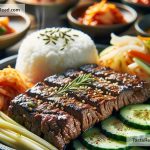Title: Bibimbap: The Delicious Symbol of Korean Cuisine
When we think about Korean cuisine, one dish stands out amidst the flavorful world of kimchi and barbecued meats: Bibimbap. This simple yet vibrant meal has not only captured the hearts and taste buds of people around the world; it’s also become a symbol of Korean culture and culinary tradition. Let’s dive into how the humble Bibimbap evolved into a world-renowned dish and became an iconic representation of Korean food.
What is Bibimbap?
At its core, Bibimbap is a mixed rice dish. The name itself translates to “mixed rice” (bibim = mixed, bap = rice). It’s a versatile dish usually served in a bowl with a bed of rice and topped with an array of vegetables, a protein source like beef or tofu, a fried egg, and gochujang (Korean chili paste). The ingredients are then mixed together just before eating, creating a delightful harmony of flavors and textures.
Historic Roots
Bibimbap traces its roots back centuries in Korean history. It’s believed to have originated from traditional Korean rituals where a variety of food offerings were mixed together after ceremonial rites. Another theory suggests that Bibimbap was a convenient way to use up leftovers before the Lunar New Year, ensuring a fresh start. One of the earliest official mentions of Bibimbap is in the late 19th century, but the dish likely evolved over many generations.
From Humble Beginnings to Global Fame
Bibimbap started as a simple, everyday meal, grounding itself in the principles of balance and nutrition. Its beauty lies in its flexibility – it can feature seasonal vegetables, various meats, or be adapted to suit dietary restrictions, making it accessible to virtually everyone. This adaptability may well be the secret to its global appeal.
The international ascent of Bibimbap began in earnest in the 20th century, particularly with the 1988 Seoul Olympics, which served as a global stage for Korean culture. As South Korea opened up, its cuisine traveled abroad, and Bibimbap became an ambassador of Korean flavors to the world. The colorful presentation and the interactive aspect of mixing the ingredients have made it especially popular in an era where food not only has to taste good but also be visually appealing and “Instagrammable.”
A Symbol of Korean Cuisine
Bibimbap embodies the essence of Korean cuisine, which is all about harmony and balance. The dish is a palette of colors, each representing different nutritional elements and harmonizing to create a balanced meal. The use of gochujang adds a depth of flavor that is distinctly Korean, striking a perfect balance between sweetness, spice, and umami. Bibimbap not only pleases the palate but also tells a story of the region’s geography, history, and traditions.
Furthermore, Bibimbap mirrors the Korean philosophy of mealtime as a communal experience. Even when served individually, the act of mixing the ingredients becomes a unifying moment, reflecting the Korean value of togetherness and community. Its simple base allows it to transcend cultural barriers, inviting people to add their touches and flavors, thus becoming a symbol of cultural exchange and understanding.
Impact Beyond Borders
The international popularity of Bibimbap has had a broader impact on Korean culture and cuisine, introducing many to the delights and complexities of Korea’s culinary landscape. From street food stalls in Seoul to high-end restaurants worldwide, Bibimbap serves as a gateway dish, often leading curious foodies to explore a wider range of Korean flavors and dishes. It’s not just a meal; it’s an experience that encapsulates the rich diversity and vibrancy of Korean cooking.
Conclusion
Bibimbap’s journey from a simple Korean dish to a global cuisine symbol is a testament to its universal appeal and the growing interest in Korean culture. Its balance, nutrition, and versatility resonate with a global audience seeking both taste and health. Beyond its deliciousness, Bibimbap carries the essence of Korean tradition, embodying the principles of harmony, balance, and community. As Korean cuisine continues to captivate food enthusiasts around the world, Bibimbap remains at the forefront, inviting everyone to mix, share, and enjoy the rich flavors of Korea.
So, the next time you find yourself in front of a bowl of Bibimbap, take a moment to appreciate not just the taste but the culture, history, and traditions it represents. It’s more than just mixed rice; it’s a symbol of Korea’s culinary legacy, shared with the world one bowl at a time.


